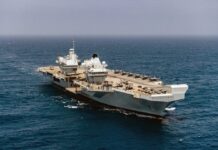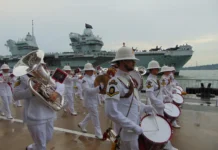
It is with great sadness that the SIA reports the death of Captain Bill Owen, a man who was a key figure in the establishment of the modern day RAN Submarine Arm.
Bill Owen was born in Aberystwyth near Cardigan, Wales, on the 16th of December 1927. After spending most of his early years and school holidays in Khartoum, Sudan where his father was the Chief Justice, he entered the Royal Navy as a Cadet Midshipman on the 1st of December 1941 to train at the Royal Naval College at Dartmouth.
After graduating as a Midshipman on the 1st of May 1945 Bill underwent further training in the training cruiser HMS Frobisher and, later, HMS Glasgow, Bill was promoted Acting Sub Lieutenant in May 1947 with four and a half months’ time gained.
In late August 1948 he obtained his Royal Aero Club Aviation certificate on a Tiger Moth Biplane at the Royal Naval Air Service station at Gosport, before commencing his submarine training in 1949. This was followed by a posting to the T Class submarine HMS Tantalus. Tantalus was a veteran of the war which would be scrapped the following year. Subsequent postings included Springer, Totem (3rd Hand), Scorcher, Sanguine, Trump and Tiptoe (as First Lieutenant).
In October 1953, the New Milton Times reported:
“Lieutenant William Lloyd Owen RN, elder son of Mr & Mrs Howell Owen of Boundway Top, Sway and Ann Lothian Nicholson, elder daughter of the late Major-General F L Nicholson CB, DSO, MC and of Mrs Nicholson of Tree Tops. Sway.”
Ann and Bill were married on 31 July 1954 and, in the same year, he completed Staff Course and qualified as a German Interpreter. He retained his German linguistic skills throughout his life, speaking with other German speakers wherever possible.
Bill successfully undertook Commanding Officers’ Qualifying Course (COQC) No. 29 in 1955 with three other students, Lieutenants Burrage, Fieldhouse & Henry, under the tutelage of “Teacher’ Commander D Hay.
Promoted to Lieutenant Commander in August 1957, Bill was appointed in command of HMS Subtle. This was followed by two years in Sydney in command of HMS Anchorite, part of the 4th Submarine Squadron based at HMAS Penguin, between 1959 and 1961.
While in command of Anchorite, the submarine visited Auckland to provide ASW training services for the Royal New Zealand Navy and during a sonar tracking exercise in the Hauraki Gulf, collided with an uncharted rock on 3 October 1960. No one was injured although the submarine spent several weeks in Calliope Dock for repairs. Bill was cleared of any blame at the subsequent court-martial but his Hydrographic Note which suggested the rock be named ‘Owen’s Knob’ was firmly rejected and Anchorite Rock remains the name on charts to this day.
On return to the UK, Bill joined the Tactical School at Woolwich, near London and sparked a security alert when he nodded o[ while taking the train home in Kent. This was the height of the Cold War and the immediate reaction of the Ministry to queries from Ann as to his whereabouts was that he must have defected! He had, of course, been woken from his slumber by the train’s conductor when the train reached the end of the line and, with no further rail services, was now stranded miles from his destination incommunicado in a freezing Waiting Room with no heating!
In 1964, the Kentish Express reported:
“Submarine commander Lt.-Cmdr. William Lloyd Owen (above), whose home is at Goodwin’s Cottage, Hartley. near Cranbrook, is the new Captain of H.M.S. Opossum. one of the Navy’s latest conventional submarines. He entered Dartmouth Royal Naval College in 1941, when he was 13. He transferred later to the submarine branch. He has earlier commanded submarines Subtle and Anchorite. Lt.-Cmdr. Owen. aged 36. is married and has two sons and three daughters.”
HMS Opossum was being built at Cammel Laird’s in Birkenhead near Liverpool and, during his command (1964-65), ventured the furthest north under the
Arctic ice cap by a conventionally powered submarine.
While surface snorting in a polynya, the O[icer of the Watch
reported to Bill that what appeared to be glow worms were
flying past the bridge. On being ordered below, a Geiger
Counter ‘swipe’ revealed loud crackling noises. The
conclusion was that this was actually fallout from Soviet
nuclear tests. Fortunately, none seemed the worse for the
experience even though the air coming in through the
induction mast and being therefore distributed throughout the boat must have had some contamination.
In 1967, Bill Owen transferred to the RAN as an Acting Commander, initially serving at HMAS Penguin in command of the RN 4th Submarine Squadron. On the 18th of August 1967, he became the commissioning Commanding O[icer of HMAS Platypus and inaugural Commander of the First Australian Submarine Squadron. Bill was confirmed in the rank of Commander in June 1969 and would remain in command of the Submarine Squadron until 1971, guiding it though its formative years.
Following a posting to HMAS Cerberus as the Training Commander in 1970, Bill joined the Naval Sta[ in Canberra as Director of Submarine Policy, where he served until 1975. During his tenure, he initiated a number of projects to enhance the warfighting capability of the Oberon class submarines; a combination that was later dubbed the Submarine Weapons Update Program (SWUP). SWUP had far-reaching implications since the submarines now had the ability to reach their potential as strategic assets for Australia and it provided the confidence, many years later, for Australia to embark on the New Construction Submarines project that delivered the Collins class class submarines. During this period, Government approved an expansion of the Submarine Force to six.
In January 1976, he would return to Sydney to command Platypus and the Submarine Squadron for a second time. This was coincident with the Australian submarine service being stretched with the introduction into service of HMA Submarines Orion and Otama, creating a manpower problem compounded by many of the early RAN submariners discharging. He was promoted to Captain on the 30th of June 1976. In December 1978, one of his final duties as the Squadron Commander was to welcome the newly commissioned HMAS Otama to the Squadron, in which his son Frank Owen was serving.
Bill’s final posting was as Naval O[icer Commanding Queensland. He retired from the RAN in 1983 and initially settled in Brisbane where he remained active in the defence sector as a consultant to industry.
Bill and his wife Ann moved back to the Canberra region in 1989, settling in the rural area of Wamboin. After Ann’s passing in 2013, Bill sold the Wamboin property and, after several years at The Grange in Deakin, moved to Warrigal Care in Bundanoon, NSW for the final 12 months of his life.
Bill was gifted in the arts with great skill on the piano and also with pen and brush.
Captain William Lloyd Owen RAN (Rtd ) passed away at Bundanoon on the 4th of October 2024 aged 96. He is survived by his children Commander Frank Owen OAM RAN (Rtd), Louise, Charlie and Sarah, nine grandchildren and four great-grandchildren. Sadly, Ann and Bill lost two daughters Jane, aged 11, in 1972 and Mary, aged 46, in 2003. Ann passed away in 2013.


